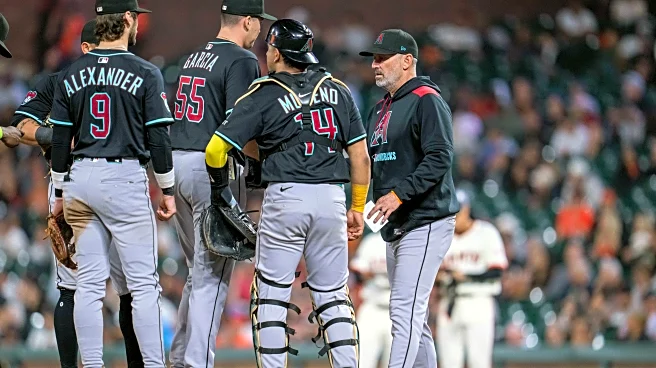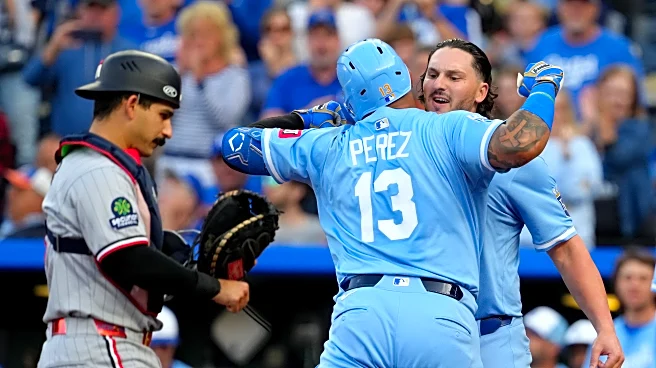Last night’s game wasn’t good.
As I was writing this, the postseason chances for the Royals had shrunk to 1.8% on Fangraphs. It’s not like their odds were good before yesterday. But this feels like it might be it, barring some miracle
Hm… what else do I have? Not a lot of other stories out there
yesterday.
Anne Rogers wrote about Jac’s rehab:
“My fiancée is on a needlepoint kick right now, so she’d be doing that,” Caglianone explained. “So I’d be talking to myself, because she would just respond with, ‘Yeah, uh-huh.’ And I was like, ‘You have no idea what I’m saying.’ But I used her as a soundboard. I’d talk through ABs. I was honestly thinking about it like a pitcher, about how they would attack a hitter.
“Trying to get better about studying the game rather than thinking it’ll just happen.”
Is this new news or am I just late to the party? I’m not familiar with Jeff Duda or “World Baseball Network”, but they have an interview where Jac says he will be playing for Team Italy in the World Baseball Classic:
In a recent interview with former MLB player Carlos Baerga, Caglianone confirmed his decision, saying, “I’m gonna play with Italy because Puerto Rico reached out late. Only about a couple months ago. I’ve been talking to Italy for years about it. So, I’ve already committed.”
Speaking of Caglianone, this is an interesting nugget in ESPN’s Power Rankings:
16. Kansas City Royals
Record: 74-72
Previous ranking: 14Other than an 11-2 win over the Twins on Saturday, the Kansas City offense has sputtered the past week as the Royals failed to make up ground in the wild-card race (and saw the Guardians pass them). If they do end up falling a game or two short, the decision to push Jac Caglianone to the majors in June will be a key failure. Among players with at least 150 PAs, Caglianone has the third-lowest wRC+ in the majors — unfortunately, he’s tied with teammate Michael Massey, who has received even more playing time. Caglianone is 3-for-17 with two RBIs since returning from the IL and is hitting .176/.364/.176. — Schoenfield
I remember all the optimism and the “this is the only logical choice” when the move was made. However, I’m not sure who he took at bats from that would have fared much better. It’s not like the Royals were trotting out league average OFs all year and took a chance, it’s a team full of sub-replacement-level OF bats.
Speaking of which:
https://www.baseball-reference.com/teams/KCR/2025.shtmlThat got me wondering. Just how bad has the Royals OF hit this year? Here’s a quick list of all the Royals who played a decent number of games in the OF, not including guys who were acquired at the trade deadline. Just a reminder: 100 OPS+ is league average. AVERAGE.
- India: 539 PA, 88 OPS+
- Isbel: 396 PA, 85 OPS+
- Waters: 219 PA, 70 OPS+
- Loftin: 187 PA, 78 OPS+
- Caglianone: 183 PA, 38 OPS+
- Rave: 156 PA, 71 OPS+
- Canha: 125 PA, 52 OPS+
- Renfroe: 108 PA, 37 OPS+
- Biggio: 83 PA, 55 OPS+
- Melendez: 65 PA, -10 OPS+ (NEGATIVE!!)
- Tolbert: 42 PA, 71 OPS+
Yikes. I mean, I knew it was bad. But I didn’t think it was that bad.
At The Athletic ($), Keith Law wrote about prospects he whiffed on:
Mike Yastrzemski, OF, Kansas City Royals
I didn’t see any of this coming, at all; I can’t find anywhere I even mentioned Yaz’s name, let alone ranked him in the Orioles’ top 20 prospects, not even right before what turned out to be his breakthrough year in 2019. I saw Yaz in high school, college and at least in High A, probably in Double A as well, and always saw what I thought was the same guy: a workmanlike player who didn’t have any above-average tools and could put together a good at-bat against mediocre pitching, but who couldn’t hit better stuff and didn’t have the power or other skills to mitigate that.
I also always dinged him for being so old for the levels he was playing at; he didn’t debut in the majors until he was 28, and didn’t produce anything in Double A until he was 25, in his third go-round there. He’s a late bloomer whose less tangible skills, like his understanding of the strike zone and instincts on the bases, carried him long enough to give him a chance to develop enough power to make himself an everyday player. I assumed that by the time he was 26 or so, that door had closed. He’s finishing up his seventh straight season of at least 2 bWAR.
A little bit of blogging.
The Royals Reporter, Kevin O’Brien, was ready to go with a game recap last night:
The reality is that the Royals have an above-average pitching staff and a below-average lineup. Thus, it makes sense why this team is pretty much average, with a 74-73 record with 15 games left in the season.
Against the Guardians, the Royals have looked very much like their June selves. It’s a team that is pressing and failing to come through in the most significant moments, sans outliers here and there. Tonight, the Royals went 0-for-6 with runners in scoring position and left eight runners on base.
Blog Roundup:
- David Lesky at Inside the Crown ($): The Pen To Win (Wednesday’s game)
- Darin Watson at U.L.’s Toothpick: This Date In Royals History–1985 Edition – September 11 – The Royals win a pitchers’ duel in Anaheim, and there’s a new hit king in baseball
- Caleb Moody at KOK: This surging Royals player is unexpectedly cementing himself into team’s 2026 plans (Spoiler: it’s Luinder Avila)
- Also, Caleb Moody at KOK: Royals aren’t doing themselves any favors leaving this young talent out of the lineup
OT: Last week, I started a three-part series on the Foundation Trilogy by Isaac Asimov. You should start there if you didn’t see it last week.
Aside: There was some chatter in the comments about the Foundation series on Apple TV. I haven’t seen it yet, but I did see some news yesterday. The season three finale airs today. And, yesterday, Apple announced they were renewing it for a fourth season.
Onto number two: Foundation and Empire. The first novel, Foundation, was made up of five books. This one is made up of only two. They’re more focused and developed than the first set.
Novel 2: Foundation and Empire
Book 1: The General
Characters: Galactic Empire General Bel Riose, Emperor Cleon II, and Privy Secretary Brodrig vs Siwennian Ducem Barr and Foundation Trader Lathan Devers
Date:195 FE
Seldon Crisis: Foundation vs Empire; External: Galactic Empire led by Cleon II and Bel Riose; Internal: No strong political leaders in the Foundation; Resolution: Riose was accused of treason and recalled by Cleon II
Plot/Notes: Empire General Bel Riose heard of “magicians” in the outer periphery and interrogates Ducem Barr on Siwenna. He goes to Terminus and finds all the stories to be true and captures Trader Lathan Devers. Fearing the threat, he requests reinforcements and Cleon II sends his slimy Secretary Brodrig to spy on Riose. Riose creates an Enclosure trap and gets as far as the Four Kingdoms. Brodrig bribes Devers to find out what Riose is really up to. Devers feeds him a story about how the Foundation has the ability to transmute metal and Riose wants that for himself so Brodrig sides with Riose over the Empire. Barr and Devers go to Trantor to try and sew internal rebellion. There, they get arrested but, as they escape, they find that Cleon recalled and arrested Riose and Brodrig.
The first chapter introduces General Bel Riose as a strong new menace, a more than worthy adversary for the fledgling Foundation: “In his relatively short career, Riose earned the title of ‘The Last of the Imperials’ and earned it well.” Emperor Cleon II is the “last strong Emperor of the First Empire”. They are meant to parallel General Belisarius and Justinian I, referred to in history as “Last of the Romans”. Word of the foundation reached Riose almost as myth- “The magicians” and tales of Hari Seldon. He realizes the danger and wants to snuff it out in its infancy. There’s also a constant drumbeat of melancholy regret not just by the characters in the story: “But there were borders to watch now; books were for old men. And half the stories told about the old days were mythical anyway. More than half.” But also a glorifying of older times and ideas- there are no more great men and those that are were born at the wrong time.
Riose is not a villain and, neither, really is Cleon II. Riose sees the merits of the Empire:
“You don’t understand, patrician, and I doubt my ability to make you. I can’t argue on your ground. You’re the scholar, not I. But this I can tell you. Whatever you think of the Empire, you will admit its great services. Its armed forces have committed isolated crimes, but in the main they have been a force for peace and civilization. It was the Imperial navy that created the Pax Imperium that ruled over all the Galaxy for thousands of years. Contrast the millennia of peace under the Sun-and-Spaceship of the Empire with the millennia of interstellar anarchy that preceded it. Consider the wars and devastations of those old days and tell me if, with all its faults, the Empire is not worth preserving.”
In fact, the reader is all but ready to root for Riose and his proclamation: “I’ll take that challenge. It’s a dead hand against a living will.”
His introduction is an interview with Ducem Barr, tying back to Onum Barr from Foundation: (Riose) “I’m too troublesome at court… but I’m too good a leader of ships and men to be disposed of shortly by being marooned in space. So Siwenna is the substitute”. Barr, plays his own game and it isn’t revealed until later that his actions are motivated by revenge against the Empire for what they did to his family decades ago: “It would be interesting to tell you certain things. It would be a psychohistoric experiment of my own.” This even sets up a challenge to psychohistory as it only works when the mob is not self-aware. In fact, Barr pretty much outlines the first book and what we know about Seldon, the Foundation, and the Empire in his conversation with Riose.
The good dramatic staging continues with the shadowy men of the Foundation discussing the threat. Again, we have a tie to the past with Hober Mallow’s illegitimate son, Sennett Forell. But it feels like they are the weaker later generations of a great king. The Federation is at a weak point: “the epic days of Hardin and Mallow had gone and with them were gone a certain hard daring and resolution”. Even they pine for the glory days: “Well, there is a good deal they had in the old days… these are the new days”. During their exchange, one complains “The government is soft” while another rebukes him saying “we are the government”, showing how the businessmen are now running the Foundation. Forell spells it out: “Patriotism be damned. Do you think I give two puffs of nuclear emanation for the future Second Empire? Do you think I’d risk a single Trade mission to smooth its path? But— do you suppose Imperial conquest will help my business or yours?”
Enter Devers, who is read like a 20s slick-talking gangster or wise guy (incidentally, on the book on CD, Riose sounds a bit like Zapp Brannigan). From another review: “Devers is the best the Foundation’s got — he’s an above-average man living in an era of mediocrity going up against the Empire’s last great men”. It’s hard to tell what is act and what is genuine and Riose chides him “don’t play with words”. A couple of chapters after the reader sees it, he describes the situation: “there are five or six fat slobs who usually run an average planet. They get the rabbit punch, but I’m not losing peace of mind over them. See. The people? The ordinary run of guys? Sure, some get killed, and the rest pay extra taxes for a while. But it settles itself out; it runs itself down. And then it’s the old situation again with a different five or six.” The book seems to imply the traders act, to a man, as a monolith of Foundation interest with self-interest secondary but that seems unrealistic.
Finally, we are introduced to Cleon II, who was wise but in failing health: “complications in this that I don’t penetrate. There may be more importance in it than would seem.” All of the characters are either personifications of Asimov’s ideas or mouthpieces for them. It would be an interesting literary exercise to have someone who is excellent with characters try to fill in the backstory. They read like history book descriptions of great men and great actions, though not fleshed out as humans. The minor characters get scarcely more than a line (“unimaginative enough to face danger without fear, he was strong and agile enough to face it successfully”) and exist only to fulfill their purpose in the plot. He requests a man with loyalty for the front and Broadrig, the exact opposite (“he lacks even the fundamental honesty of honorable corruption; he doesn’t stay bribed; not for any sum”), is sent.
The buildup is wonderful, but the payoff pales. It feels like Asimov is a little too content to let history be his guide rather than make a more compelling tale. Riose completes his enclosure military maneuver and tension mounts as he takes system by system, eventually reaching one of the four kingdoms, Loris. The situation looks even more dire when Riose reveals he knows both Barr and Devers have been playing him (“Are you the only sensible man then? You neither fight nor flee, but turn traitor without urging. You are unique, amazingly unique—in fact, suspiciously unique.”). We have reached the apex of the named conflict Foundation and Empire.
But then it collapses suddenly. Barr bashes in the general’s head and the pair escapes. They have a half-baked plan to go to Trantor (Devers: “the whole busy, unheeding life of a world-metropolis cast him into the horrible gloom of isolation and pygmyish unimportance”) and talk to the Emperor, but even the readers know this is futile. Barr advocates doing nothing, putting his faith in psychohistory, which leads to a confrontation between Barr and Devers where Devers accuses Barr of not caring. But Barr retorts: “It is on a Foundation victory that Siwenna’s hopes depend. It is for a Foundation victory that my sons are sacrificed. And Hari Seldon does not precalculate the inevitable salvation of Siwenna as he does that of the Foundation. I have no certainty for my people—only hope.” They try to bribe their way into the capital only to be arrested and barely escape in swashbuckling fashion. During their run from Trantor, they see a paper with the resolution that Riose and Broadrig were arrested and the war is over. Devers had given Broadrig some fake story about how he told Riose about a metal transmuter that would allow him to control the Empire’s economy so Broadrig threw his lot in with Riose instead of the Emperor, unbeknownst to Riose.
In the end, there’s exposition between Forell, Devers, and Barr, not dissimilar from an Agatha Christie novel:
“It never penetrated earlier, but once it was over and I could . . . well . . . look at the answers in the back of the book, the problem became simple. We can see, now, that the social background of the Empire makes wars of conquest impossible for it. Under weak Emperors, it is torn apart by generals competing for a worthless and surely death-bringing throne. Under strong Emperors, the Empire is frozen into a paralytic rigor in which disintegration apparently ceases for the moment, but only at the sacrifice of all possible growth.”
Further:
“A weak general could never have endangered us, obviously. A strong general during the time of a weak Emperor would never have endangered us, either; for he would have turned his arms towards a much more fruitful target. Events have shown that three-fourths of the Emperors of the last two centuries were rebel generals and rebel viceroys before they were Emperors.
So it is only the combination of strong Emperor and strong general that can harm the Foundation; for a strong Emperor cannot be dethroned easily, and a strong general is forced to turn outwards, past the frontiers.
But, what keeps the Emperor strong? What kept Cleon strong? It’s obvious. He is strong, because he permits no strong subjects. A courtier who becomes too rich, or a general who becomes too popular is dangerous. All the recent history of the Empire proves that to any Emperor intelligent enough to be strong.”
On the one hand, it’s the pinnacle of the Foundation books: this feels like the conflict we have been building to since the beginning. It’s easy to criticize this as more of the same, a warming over of Roman history, and pulpy action. But that’s selling it short. The buildup is brilliant and the characters, while still mostly flat, are much more memorable than previously in the series.
However, it feels a little clumsier than it should be. Is it sequelitis? The story is longer than any of the previous ones. There wasn’t really a need to tie into Siwenna or Onum Barr –there was time to adequately give characterization. It feels a little contrived now after not doing it in the first book, when it would have helped more. Similarly, there’s some playing fast and loose with the idea of psychohistory as noted above.
In the first book, there was a delicate sense of scale as the problems seemed large enough but not too large. This is the first time the resolution hasn’t quite felt as satisfying. I didn’t feel cheated, per se, but it didn’t feel as satisfying as before. This wasn’t the idea of “doing nothing” that won the day in the final book of Foundation: that by doing something, they were actively working against the dead hand of Hari Seldon. And Seldon, himself, has taken an almost exaggerated saintly quality, not just in the fictional universe (“Hari Seldon’s dead hand wins the opening round” “Your Seldon wins nothing.”) but also in the exposition itself (“But in that short period, it proved itself the most powerful instrument ever invented for the study of humanity”). He and his mythology have become larger than life.
While the writing is Asimov’s best to date, it fizzles out. The idea of psychohistory is becoming too fatalistic and hard to dramatize properly. The Foundation’s worst took out the Empire’s last best in less than 200 years. That overshadows much in this excellent story – it’s my favorite in the entire trilogy. In the closing words Forell muses “There are no more enemies”. Barr suggests “There’s a Second Foundation” but Forell dismisses it as centuries away. Devers suggests “internal enemies”. But, really, it feels like these are all the worlds that the Foundation was meant to conquer. I think that’s where the second book comes in.
* * * * *
Book 2: The Mule
Characters: Terminus Federation citizen Bayta and Haven Trader Toran, Psychologist Ebling Mis, Intelligence officer Han Pritcher, clown Magnifico Giganticus/mind controlling mutant The Mule
Date: 300 FE
Seldon Crisis: Civil War; External: War between Independent Traders and Central Aristocracy; Internal: Democratic underground and inefficient and ineffective bureaucracy; Resolution: democratic reform; Crisis did not occur due to unforeseen mutant Mule’s attack
Plot/Notes: The Foundation is well on its way to establishing a pre-ordained second empire and is behaving as such. The central oligarchs are consolidating their power with some democratic resistance while the independent trading worlds are the rebelling periphery. Newly married, Bayta is from the former while Toran from the latter. As part of the democratic underground, they are sent to investigate a mutant known as the Mule on Kalgan. There they rescue the clown Magnifico Giganticus from a mob and barely escape the planet with Foundation intelligence officer Han Pritcher, who had been investigating The Mule. The Mule retaliates against the Foundation, winning surprising victories. Psychologist Ebling Mis realizes they are in the middle of a Seldon Crisis, and the elite, led by ineffective bureaucratic mayor Indbur III, go to the Time Vault to see Hari Seldon. Only he had predicted a civil war, not the rise of a mind-controlling mutant. The Mule takes over The Foundation that day. Toran, Bayta, Mis, and Magnifico barely escape, traveling to Haven, Neotrantor, and then to Trantor. They continue to barely escape calamity, finding the sacked ruins of Trantor and letting Mis study at the Great Library, which is still intact. A dying Mis reveals that the Second Foundation, their final hope, is one of psychologists rather than physicists. Right as he is about to reveal where the Second Foundation is, Bayta shoots him. She realized that Magnifico was The Mule and she couldn’t reveal their only hope to him.
This is much longer than any other story so far in the Foundation trilogy and reads more like a standalone novel. The Toran and Bayta character introduction is that of characters perfectly placed on a representative world, throwing you straight into the crisis and giving you all the exposition you need. It doesn’t feel contrived as, so far, Asimov has always used the characters for plot devices so it’s expected. By the end of the book, this is no longer the case.
The outer trading worlds want to rebel against the Foundation, but they know they cannot in a point/counter-point discussion between the “kids”, Toran’s father, Fran, and uncle Randu (to Fran): “When you listen to the little thoughts deep inside you, you know he is. But they’re uncomfortable thoughts, so you drown them out with that roar of yours. But they’re still there.” Against: “No, not a chance. There’s not one of those generals who doesn’t know that an attack on the Foundation is suicide. Bel Riose of the old Empire was a better man than any of them, and he attacked with the resources of a galaxy, and couldn’t win against the Seldon Plan. Is there one general that doesn’t know that?” For: “Not every man with sufficient ability and sufficient ambition would believe in Hari Seldon and his laws of psychohistory.” In contrast to the previous book, Seldon is no longer a mythical figure, but his ideas are concrete facts, believed by all in the Foundation.
As such, the Foundation has moved from the jet-setting, quick-thinking teenagers of the galaxy who do everything by the seat of their pants to the stodginess of the Empire in the 100-odd years since we’ve last seen them (“we could take advantage of such a crisis to force a compromise with the despots of the Foundation”). The independent traders are now depicted as men of action while the leaders of the Foundation are feckless bureaucrats.
The intros of Mayor Indbur III and Captain Han Pritcher, intelligence officer, are similarly textbook to Toran and Bayta’s: Indbur is described through exposition while Pritcher is described by Indbur reading his military record. Even more is revealed in that exchange as their behaviors are contrasted and their beliefs in this conflict puts their dominant characteristics at odds: “in my administration, nothing is left to chance. Order! System!” vs “Excellence, I have been told all this. But as servant of the State, I must serve faithfully—and he serves most faithfully who serves Truth… I am not a tax collector to be sent on a child’s errand.”
Toran and Beyta go to Kalgan to gather intelligence on The Mule and instead run into a situation with the clown Magnifico Giganticus. There, they offend the guards of the mule (“The dark man spoke with the dangerous softness that meant he had little need of shouting to enforce his whims”) and attract the attention of Pritcher. We see the Foundation’s new reputation as Toran merely has to say that he is a citizen of the Foundation to get out of trouble: “The Mule’s name might excite fear, but it was, after all, a new name and scarcely stuck as deeply in the vitals as the old one of the Foundation—that had destroyed the Empire—and the fear of which ruled a quadrant of the Galaxy with ruthless despotism.” It’s an obvious reference to being a Roman Citizen and callback to how much this epic owes to the fall of the Roman Empire.
They escape easily enough but start seeing newscasts about how The Mule is going to retaliate against the Foundation for the theft of his clown and curiously, he begins winning against them. But the Foundation knows their manifest destiny is to eventually turn the tide and win when the time is right, as Hari Seldon predicted. Toran adds to the mystery of the mule: “The Mule is a shrewd operator—far too shrewd not to realize the advantage of the magnetism and glamour of personal leadership. If he gives that up, it’s for a reason. That reason must be the fact that personal contact would reveal something that is of overwhelming importance not to reveal.”
Back on Terminus, we are introduced to Ebling Mis and he is glorious to listen to:
“There was reason to the fact that the element known as ‘pure science’ was the freest form of life on the Foundation. In a Galaxy where the predominance—and even survival—of the Foundation still rested upon the superiority of its technology—even despite its large access of physical power in the last century and a half—a certain immunity adhered to The Scientist. He was needed, and he knew it. Likewise, there was reason to the fact that Ebling Mis—only those who did not know him added his titles to his name—was the freest form of life in the ‘pure science’ of the Foundation. In a world where science was respected, he was The Scientist—with capital letters and no smile. He was needed, and he knew it.”
He’s not necessarily vain in his self-importance but he doesn’t suffer fools or bureaucracy and feels like reading one of the characters of the “old” Foundation.
He tells the all-powerful mayor to “shut up” and knows he can do so because he knows about the impending Seldon crisis. Indbur accuses him: “This is treason!” and he blows right by it: “It certainly is but what are you going to do about it?” He’s a psychologist, the best since Seldon, and he’s been trying to re-discover psychohistory, studying the vault and putting his scientists to work on “little unconnected piece(s)”. He realizes the fifth Seldon crisis is only a couple of months away.
The scene shifts back to a meeting between the independent trading worlds. Randu meets with the two other strongest fleets and tries to get the traders to join the fight on the side of the Foundation, viewing The Mule as a greater threat (though he “frowned and despaired at the cobweb texture of his argument”). By the end of the meeting, The Mule has also attacked their world and Randu foreshadows: “I am afraid a monster is grown that will devour all of us. Yet we must fight him.” We also got a brief sidetrack with the Visi-Sonor, something more akin to a 70s device, and inspiring Futurama’s Holophonor. It serves a minor purpose in the book but is iconic so the disproportional time used makes it memorable.
There are some religious parallels here, intentional or not, with The Mule getting his start at age 30 and being a bit of a savior, upsetting the current order of the day. Asimov has obliquely played with religious themes throughout the series, but never allegorically. Also, Heinlein echoed some of these ideas a decade later in Stranger in a Strange Land (published in 1961 but coming from a 1948 brainstorming session; Foundation and Empire was published in 1945 – so maybe there was just something in the zeitgeist of the time). The Mule shares some similarities to Valentine Michael Smith and Ebling Mis to Jubal Harshaw. But they are in distinctly different settings.
The scene in the time vault is a (semi-predictable) twist worthy of a mid-season finale for a television show. The incompetent Indbur and other rulers of The Foundation, certain in their psychohistorical destiny, show up expecting an answer from Hari Seldon. Instead, he tells them about the civil war with the independent traders they should have just solved and the room is thrown into chaos. The power goes out and The Mule takes over Terminus. There is still drama as the reader was reminded a couple of times that the people controlling the foundation are not The Foundation. Just because the Indbur government falls doesn’t mean Seldon’s plan failed or that the Foundation won’t live on.
Asimov finally found a way to break free of the structure that had made him increasingly frustrated with writing The Foundation story. The story loses some speed as 4 months pass at the chapter break: the Foundation has fallen and independent trading worlds put up only token resistance. The mood of the book quickly changes as our heroes in the Foundation flip from being part of the new empire to being the rebellion. There’s a little war-is-hell in some scenes on Haven, where our protagonists escaped, and there’s even Bayta’s glib: “Don’t you know it’s fashionable to be patriotic?”
Bayta’s the first major female character (and only the second total), and she’s strong and competent. She looks very different from most female literary characters in the 1st half of the 20th century. Maybe this is the result of women in the workplace during the war – better literary critics and historians could probably say. There’s a great exchange where Toran says “Stirs your mother-complex, Bay, that’s what he does. Someday we’ll have a baby, and then you’ll forget Magnifico.” Without missing a beat, Bayta responds: “Strikes me that you’re all the stirring my mother-complex can stand.” That witty banter between a male and female as equals is more of a 90s or modern character exchange than something of the time.
The novel doesn’t completely escape its previous structure. As the Seldon plan fails, it’s revealed that all didn’t believe it. One of the ideological mouthpieces, Han Pritcher : “We’ve been blinded by Seldon’s psychohistory, one of the first propositions of which is that the individual does not count, does not make history, and that complex social and economic factors override him, make a puppet out of him”. Some conspirators, including Pritcher, set up a plan to assassinate The Mule, but it was predicted and failed. It’s as if Asimov is wrestling between the psychohistory literary device that the novel was built on and the idea that an individual cannot do much against overriding systems beyond their control. Really, though, it was a clumsy plan, and The Mule is too strong to be beaten by such a simple plan.
The pace of the novel drags after Terminus falls. Our main characters escape Terminus, but it’s off-screen. Haven falls, but it’s off-screen. The assassination attempt fails. All seems lost. Toran, Bayta, and Mis hold onto the hope that they can find the Second Foundation and it doesn’t suffer the same fate. They’re stopped by a ship (“six men and six blasters are eloquent arguments”), they stop at NeoTrantor, and then they go to Trantor itself to study, their final goal.
There are valuable-ish plot points along the way. But, dramatically, it just emphasizes the hopelessness of the situation: they really have no idea how to beat The Mule. The stop by the ship gives another clue to who The Mule is and provides a little Pritcher characterization, but is mostly superfluous. The stop on Neotrantor shows you just how far the empire has fallen. In particular, the scene with the senile Dagobert IX is just sad. You see the treachery of other weak rulers. We come full circle as the almighty Trantor is reduced to what the four kingdoms of the periphery were way back when they were beaten by the fledgling Foundation.
The scenes at Trantor again bring the reader back to the books’ Roman origin: “The huge, metal world was in jagged splinters. The towering thrusts of the multitowers from the single world-girdling base were torn and empty—still bearing the original blast-holes and firegut—shards of the Great Sack of forty years earlier.” The Roman Empire has fallen and they even talk of the Great Sack. The completely metal world has grass again and, fortunately, the university is untouched, kept as a relic of the older age.
The chapter title “Death of a Psychologist” gives away the fate of the wonderful Ebling Mis. But not before he encapsulates the meta-conflict facing the galaxy. It feels more modern than science fiction of that era: “Yes. If the Mule’s descendants inherit his mental powers—You see? Homo sapiens could not compete. There would be a new dominant race—a new aristocracy—with homo sapiens demoted to slave labor as an inferior race. Isn’t that so?” And while the slavery is the direct threat, it’s the fear of the evolution of the human species.
He is clearly dying of an unknown ailment, but making progress on finding the Second Foundation. Later, in explaining what was going on, we get some more about how this really is the best of the dark ages, but nothing compared to great men during a great empire (“Ebling Mis was the bull’s-eye. His potentialities were high, and I needed him… With his mind at high efficiency, he might possibly have duplicated the work of Hari Seldon”).
Dramatically, Bayta kills Mis. In detective story fashion, Bayta reveals that she discovered who The Mule was and he (Magnifico) reveals himself. For much of the chapter, the reader is not entirely sure which person was “sane”. The colorful Mis is dead, Han is a company man for The Mule, Toran has been manipulated all along, and Bayta- the only untouched one- is partially broken by circumstance. During the denouement, many of the dots are connected.
The Mule tells his story, which feels more modern: “Maybe you can understand it. Maybe you can try to understand it. It isn’t easy to be a freak—to have a mind and an understanding and be a freak. Laughter and cruelty! To be different! To be an outsider! You’ve never been through it!” He’s not really mad- he’s just disappointed that his main plan didn’t work and he’s planning revenge against the galaxy for his difficult childhood. The betrayed Bayta make a premature declaration of victory over The Mule. However, it feels hollow: he’s extremely powerful and we’ve established that not only are we no longer locked into the Seldon plan but that they may not be ready. Asimov is re-establishing a level literary playing field and anything could happen in the final book.
A couple of final notes: Because this is the most complex story yet, it’s not quite as tightly wound. The emotional manipulation plot device is both too strong and too arbitrary. The other conflicts seemed locked in and believable as part of the Seldon plan. However, again, maybe this is part of breaking away from the rigidity of the Seldon plan. After all, this is the perfect villain for a Foundation with no psychologists. Meanwhile, the Second Foundation is just the foil to beat this “unbeatable” villain.
For Song of the Day, it’s been a couple of years since I’ve revisited what may be my favorite video game soundtrack, the original Xenoblade Chronicles. That’s far too long.
Below are our previous visits to this soundtrack:
- Royals Rumblings – News for September 7, 2018 – “Engage the Enemy”
- Royals Rumblings – News for March 15, 2019 – “Those Who Bear Their Name”
- Royals Rumblings – News for January 31, 2020 – “One Who Gets in Our Way”
- Royals Rumblings – News for January 8, 2021 – “Mt. Valac (Night)”
- Royals Rumblings – News for April 7, 2023 – “Guar Plain”
We also did the following:
- Royals Rumblings – News for November 9, 2018 – Xenoblade Chronicles 2 – “Battle!”
- Royals Rumblings – News for February 11, 2022 – Xenoblade Chronicles 3
We haven’t done the “Main Theme” yet from the title screen.

















